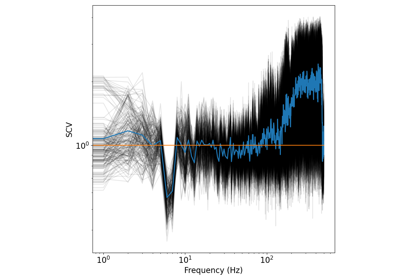neurodsp.spectral.compute_spectral_hist¶
- neurodsp.spectral.compute_spectral_hist(sig, fs, window='hann', nperseg=None, noverlap=None, nbins=50, f_range=[0.0, 100.0], cut_pct=[0.0, 100.0])[source]¶
Compute the distribution of log10 power at each frequency from the signal spectrogram.
- Parameters:
- sigarray
Time series of measurement values.
- fsfloat
Sampling rate, in Hz.
- windowstr or tuple or array_like, optional, default: ‘hann’
Desired window to use. See scipy.signal.get_window for a list of available windows. If array_like, the array will be used as the window and its length must be nperseg.
- npersegint, optional
Length of each segment, in number of samples. If None, and window is str or tuple, is set to 1 second of data. If None, and window is array_like, is set to the length of the window.
- noverlapint, optional
Number of points to overlap between segments. If None, noverlap = nperseg // 2.
- nbinsint, optional, default: 50
Number of histogram bins to use.
- f_rangelist of [float, float], optional, default: [0, 100]
Frequency range of the spectrogram to compute the histograms, as [start, end], in Hz.
- cut_pctlist of [float, float], optional, default: [0, 100]
Power percentile at which to draw the lower and upper bin limits, as [low, high], in Hz.
- Returns:
- freqs1d array
Frequencies at which the measure was calculated.
- power_bins1d array
Histogram bins used to compute the distribution.
- spectral_histarray
Power distribution at every frequency, as [n_bins, freqs].
Notes
Histogram bins are the same for every frequency, evenly spacing the global min & max power.
Examples
Compute the distribution of power, which is the spectral histogram:
>>> from neurodsp.sim import sim_combined >>> sig = sim_combined(n_seconds=10, fs=500, ... components={'sim_powerlaw': {}, 'sim_oscillation': {'freq': 10}}) >>> freqs, power_bins, spectral_hist = compute_spectral_hist(sig, fs=500)
